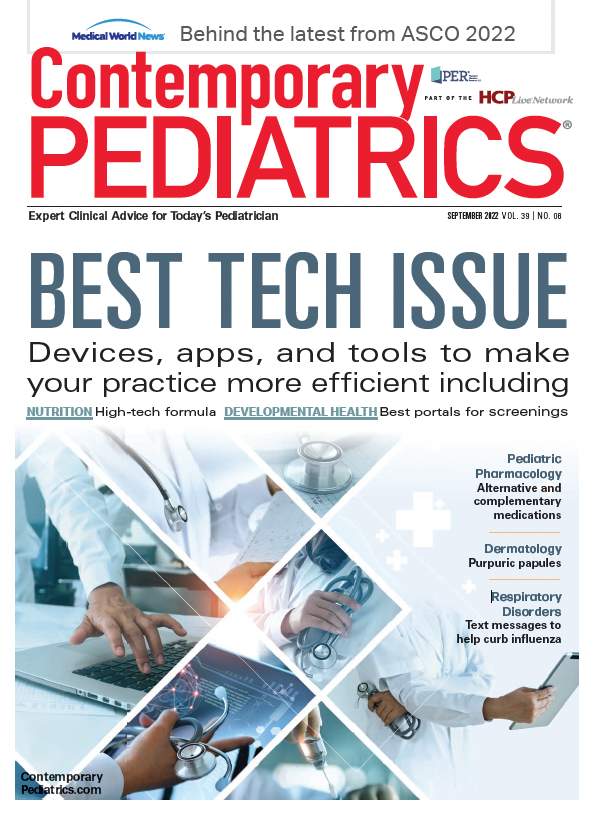The COVID-19 pandemic has fast-tracked the development of technologies for improving patient care. Patients routinely use at-home COVID-19 tests to screen for SARS-CoV-2 infections, virtual visits to obtain care from their primary care providers, and personal protective equipment to prevent the spread of disease. Likewise, pediatricians are using in-office assays to diagnose patients with influenza, respiratory syncytial virus, COVID-19, Streptococcus, and Lyme disease, as well as using online portals to help identify patients who need treatment for depression and anxiety.
A consequence of “pandemic pediatrics” is that we are more receptive than ever to adopting new technology for improving care.
What follows is this year’s selection of devices and technologies that you might consider integrating into your practice.
An app to identify plagiocephaly and brachycephaly
Most pediatricians are aware that plagiocephaly (asymmetric head shape) and brachycephaly (wide head shape) occur frequently in young infants, with some estimates placing the incidence as high as 19.7%.1 Plagiocephaly and brachycephaly occur due to prolonged pressure on the skull before or after birth. They are more easily corrected before ossification begins at aged 5 to 6 months. Congenital muscular torticollis, resulting from shortening of the sternocleidomastoid muscle unilaterally, can also contribute to the development of these conditions. Plagiocephaly and brachycephaly, if not diagnosed and left untreated, place an infant at risk for facial asymmetry, mandibular asymmetry, asymmetric motor skills, and increased risk of developmental delay.
Treatment of brachycephaly and plagiocephaly with or without congenital muscular torticollis initially involves range-of-motion and positional therapy. Often affected children who are diagnosed late or do not improve with these measures are referred for physical therapy. If diagnosed after 5 months of age or when other therapies do not produce adequate improvement, helmet therapy is indicated.
It is estimated that only 100,000 of the 720,000 babies born each year with plagiocephaly and/or brachycephaly are treated, leaving the remainder undiagnosed and untreated.1
Two scientist-parents whose child was diagnosed with plagiocephaly thought there should be a better way to screen for these conditions and to monitor improvement with therapy. They joined with other scientists to investigate the possibility of making a mobile application to facilitate the diagnoses. The company PediaMetrix was formed in 2018, and after years of research and development, it is marketing a prescription-based mobile application called SoftSpot.
Neurosurgery and craniofacial centers employ hand calipers to measure the cranial index and the cranial vault asymmetry index, to determine if the skull shape is abnormal. The oblique diagonal difference is a measurement of the asymmetry of the skull. These measurements quantify the severity of the problem and are used to determine if the infant would benefit from positional and range-of-motion therapy, physical therapy, or helmet therapy.
The SoftSpot app is available on Android and iOS platforms. To use, a cap is placed on the infant’s head to prevent artifacts due to the baby’s hairline, a sticker is placed on the top of the head, and a short video is taken via the SoftSpot app. The video is then uploaded to the PediaMetrix site, where artificial intelligence–based algorithms compute cranial measurements. A report is sent to the pediatrician who can discuss it with parents and make recommendations. Measurements are taken monthly for infants being observed or receiving therapy, and a progress report is sent to the pediatrician.
The app is easy to use and costs $65. It lends itself to telehealth visits and can help identify the 600,000 babies with plagiocephaly or brachycephaly who go undiagnosed and untreated.
A green screen for improving video visits
I’ve been doing telehealth visits for many years, mostly for following patients whom I treat for attention-deficit/hyperactivity disorder and/or anxiety or depression. The quality of the visit depends on several factors, including bandwidth and the quality of the microphone and webcam at both ends of the virtual visit. Particularly for my younger patients, I find I can improve patient and parent engagement by using virtual backgrounds with my Zoom calls, such as a video showing me on a warm beach with the waves rolling in or images with patient-pleasing designs and colors. Although Zoom virtual visits can be used without a “green screen,” background images or videos can be distorted unless you use one.
An affordable and versatile 56-inch circular green screen is the Webaround, which can be purchased on Amazon for $50 or less. The Webaround is attached to a chair with Velcro straps and positioned appropriately in the room used for virtual visits. In my experience, it is a complicated process to refold Webaround so that it can be placed back in its transport bag, so I just leave it attached to a chair in a room in my office where I do telehealth visits.
The best resources for expediting otitis media diagnosis
Although pediatric health care providers look at many tympanic membranes over the course of their careers, it is not always easy to identify acute otitis media (AOM) and distinguish it from otitis media with effusion. AOM is usually treated with antibiotics; otitis media with effusion is not. (The acoustic otoscope, described elsewhere in this issue, is now available and can quickly identify children without middle-ear effusions.)
Apps for this and that
I’ve always placed Pedi QuikCalc, created by pediatrician W. Kent Bonney, MD, high on my list of favorite medical apps. A new version (5) will likely be available by the time you read this. The app was completely rewritten to be faster and more customizable. My favorite features include an easy calculator for determining percentage weight loss, an intravenous fluid calculator, a bilirubin risk category tool, a medication dosage calculator, and so much more.
We are frequently confronted by puzzling rashes, with or without systemic symptoms, that make us wish we had a standby dermatologist to assist with the diagnosis. The VisualDx support system facilitates accurate diagnosis of hundreds of skin conditions. One describes the lesions and any systemic symptoms, and a list of possible conditions with photos pops up automatically. There are detailed descriptions of the displayed dermatologic conditions, along with treatment recommendations and patient handouts. You can even earn continuing medical education credits for using VisualDx. It is very reasonably priced at $400 per year. Additionally, one can pay $500 for a premium version of VisualDx that includes DermExpert. With this extra feature, one takes a photo of a lesion, and the application uses artificial intelligence algorithms to help identify the lesion, presenting a choice of 5 top possibilities. Recent study findings showed that DermExpert could identify the correct diagnoses 68% of the time, which was twice as accurate as physicians without diagnostic assistance.5
As you know the American Academy of Pediatrics revised its developmental guidelines this year. To help parents identify their children’s developmental milestones according to the new guidelines, the CDC released the Milestone Tracker App for parents. The app features easy-to-use illustrated checklists and provides numerous tips for encouraging development. Parents can use the app to identify developmental concerns that can be discussed with their pediatrician at well-child visits.
Michael Poole, MD, an ear, nose, and throat physician, has developed a wonderful resource for primary care providers in the form of a video book called Otitis: The Expert’s Diagnostic Guide. It is available free via Apple Books and contains dozens of high-resolution images and videos to improve your diagnostic acumen. It details the best way to visualize and describe an ear exam and features numerous interesting cases.
In addition, to improve diagnosis of AOM, WiscMed is now selling its excellent Wispr Video Otoscope via a subscription model, making
acquisition a no-brainer. With the monthly subscription, one pays just $54 per month for 30 months. The plan includes WisprCare, a 2-year accidental damage plan that costs $119 if purchased separately. The WiscMed website also features Wispr University, which is filled with instructive images and cases discussions of ear canal and tympanic membrane pathology.
Are you burned out?
Too many physicians are overwhelmed with practice-related obligations. Burnout is a well-recognized clinical syndrome associated with a loss of enthusiasm for work, negative feelings, and a low sense of personal accomplishment. Additional symptoms include fatigue, poor judgment, guilt, and feelings of ineffectiveness.2
In other words, if you don’t look forward to coming to work, can’t wait for your day to end, and believe you are losing your edge, you likely are experiencing burnout. The condition was described in detail by psychologist Christina Maslach, PhD, a professor of psychology (emerita) at the University of California, Berkeley. In the 1970s, she developed a burnout assessment tool called the Maslach Burnout Inventory, which is considered the gold standard for measuring burnout symptoms.3
The Physicians Foundation 2021 Survey of American Physicians is the most recent survey of physician opinions on medical practice and burnout. In this survey of more than 2504 physicians, 61% of those surveyed reported frequent or constant feelings of burnout, up from 58% in 2020. More frequent burnout rates were reported by female vs male physicians (69% vs 57%), and rates were high in primary care (66%) vs specialty care (59%) providers.4
It would be prudent to determine if you suffer from professional burnout or are at risk for developing burnout. You can take a version of the Maslach Burnout Inventory online at www.mindgarden.com/117-maslach-burnout-inventory for just $15. In addition, the American Medical Association has lots of resources for treating and prevent burnout at https://edhub.ama-assn.org/steps-forward.
Inexpensive computers, tablets, and more
Physicians are now using many tablets in their offices to expedite patient questionnaires. In most instances, these are scored automatically. Elsewhere in this issue, I discuss mental health portals that can identify patients with problems warranting treatment. High-quality tablets tend to be expensive and, unfortunately, too often “go missing.” One of the best resources for obtaining high-quality electronics for office use is BackMarket.com. Refurbished computers and tablets are sold with a one-year warranty and are quite affordable. For example, a used and reconditioned iPad sells for anywhere from $100 to $300 dollars. Reconditioned laptops sell usually for $500 to $1000, depending on specifications.
References:
1. Rogers GF. Deformational plagiocephaly, brachycephaly, and scaphocephaly. part 1: terminology, diagnosis, and etiopathogenesis. J Craniofac Surg. 2011;22(1):9-16. doi:10.1097/SCS.0b013e3181f6c313
2. Shanafelt TD, Boone S, Tan L, et al. Burnout and satisfaction with work-life balance among US physicians relative to the general US population. Arch Intern Med. 2012;172(18):1377-1385. doi:10.1001/archinternmed.2012.3199
3. Maslach C, Jackson SE, Leiter MP. Maslach Burnout Inventory: third edition. In: Zalaquett CP, Wood RJ, eds. Evaluating Stress: A Book of Resources. Scarecrow Press; 1997:191-218.
4. The Physicians Foundation 2021 Physician Survey: COVID-19 impact edition: a year later. The Physicians Foundation. June 5, 2022. Accessed August 2, 2022. https://physiciansfoundation.org/physician-and-patient-surveys/the-physicians-foundation-2021-physician-survey/
5. Dulmage B, Tegtmeyer K, Zhang MZ, Colavincenzo M, Xu S. A point-of-care, real-time artificial intelligence system to support clinician diagnosis of a wide range of skin diseases. J Invest Dermatol. 2021;141(5):1230-1235. doi:10.1016/j.jid.2020.08.027


























